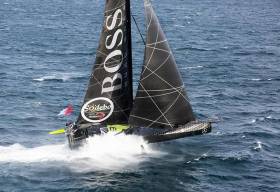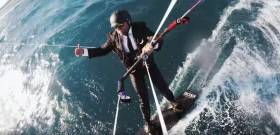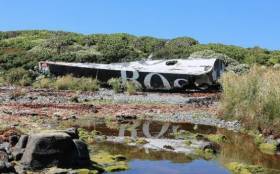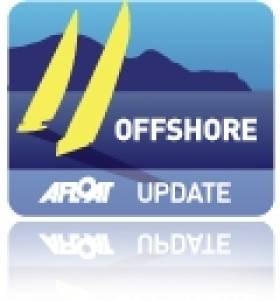Displaying items by tag: Hugo Boss
I got to helm Hugo Boss for a while on Tuesday off Cork Harbour. The tiller surprised me. I thought, with the size and length of this IMOCA 60 round-the-world ocean racer, I would be holding a heavy tiller, requiring a lot of effort. It was light and the boat quickly responsive. The grinder, which I tried later, was different, heavy and demanding effort for the main and headsails, with serious sheet loads. A very impressive boat, a foiler, “nothing too complicated in the equipment,” I was told, everything capable of repair by the solo sailor.” The boat designed and built in weight for maximum speed achievement.
I was aboard to meet Cork sailor Nicholas ‘Nin’ O’Leary and Alex Thomson who raced it around the world in the last Vendee Globe, finishing second in January after 74 days, 19 hours and 35 minutes at sea alone, becoming the fastest British solo sailor ever.
Royal Cork Yacht Club member ‘Nin’ O’Leary intends to become the first Irishman to complete the race when he sails the next one in 2020. “I’m a very competitive guy,” he told me aboard, “I’m going to do it.”
He has been sailing with Thomson working-up to that aim. They sailed the Fastnet Race last month and may do the Barcelona World Race next year.
Listen to ‘Nin’ O’Leary on the PODCAST and to Stewart Hosford, CEO of ‘Ireland Ocean Racing,’ formally launched in Cork this week to “increase the profile of competitive Irish ocean sailing and racing, inspire a new generation of competitors and deliver future Irish champions in the sport.”
Hosford managed the Hugo Boss Alex Thomson campaign of which he has been CEO, so brings to the Irish campaign significant experience and expertise. “This is the start of a journey,” he told me. “It will need sponsors and investors. What can be achieved is huge.”
Only 100 sailors have succeeded in sailing single-handed non-stop around the world and no Irish sailor has yet completed the Vendée Globe. A Cork sailor could do that, if the project gets the support needed.
Hugo Boss left Cork heading for Dublin to spread the word and the prospects for ‘Ireland Ocean Racing.’
LISTEN to the PODCAST here:
Tom MacSweeney presents THIS ISLAND NATION maritime programme on radio stations around Ireland
Ireland & Cork Sailing On A High As Vendee Globe Hits World Target
Enda O’Coineen may have exited the Vendee Globe in dramatic fashion on New Year’s Day when, as he drolly put it, Kilcullen Voyager stopped stone dead as she zapped into the back of a Southern Ocean wave, but his enormous mast just continued straight on with an almighty crash as it broke off clean at the deck. But this ruthless race continues on its way, and there’s still much of very specific Irish interest in it as the leaders approach the finish. W M Nixon gives us his own take on it all, and then tells us a tale out of school about Irish involvement.
It has to be the oddest geography lesson ever provided. And it has to be the most unexpectedly energetic way of promoting a relatively unknown region of France which was formerly almost exclusively associated with a relaxed way of life.
Once upon a time, the Vendee was a place which you’d usually associate with the gentler things in life. Things like good food and summer wine enjoyed in a sleepy siesta lifestyle in gently dusty villages inland from some fine beaches, villages where life moves slowly under the kindly shade of many trees, in a latitude which is not so far south as to be overly hot in summer, yet not far enough north to experience harsh winters.
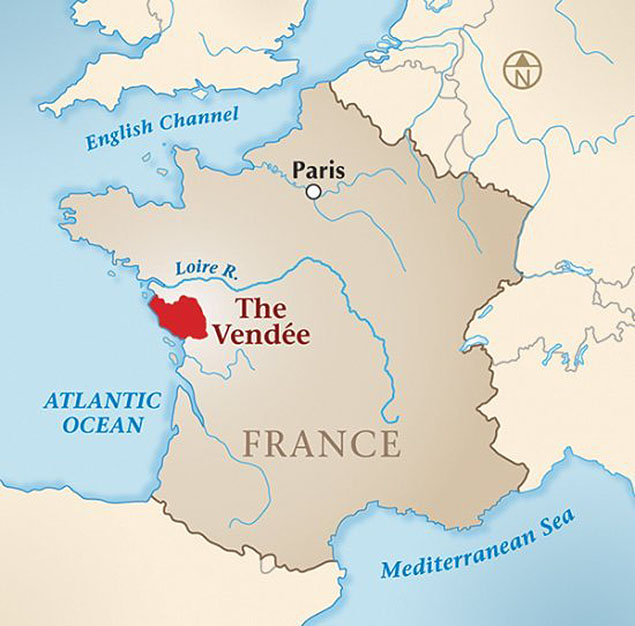 Little place that thinks big – France’s Vendee region has put itself firmly on the world map by sponsoring the Vendee Globe
Little place that thinks big – France’s Vendee region has put itself firmly on the world map by sponsoring the Vendee Globe
It’s about the size of an average Irish county. Yet right now, France’s modestly endowed Vendee region is being promoted as a place of world significance by extreme sportsmen taking part in a rugged sailing exercise with the most severe physical and life-threatening challenges, subsisting on a meagre diet which would rightly produce rioting in any self-respecting prison.
Welcome to the world of the Vendee Globe. That is, in the unlikely event that you aren’t already addicted to following it on a daily or indeed hourly basis. This still almost unbelievable round the world non-stop marathon continues to have an air of crazy novelty and enduring fascination, even though it was first staged in 1989.
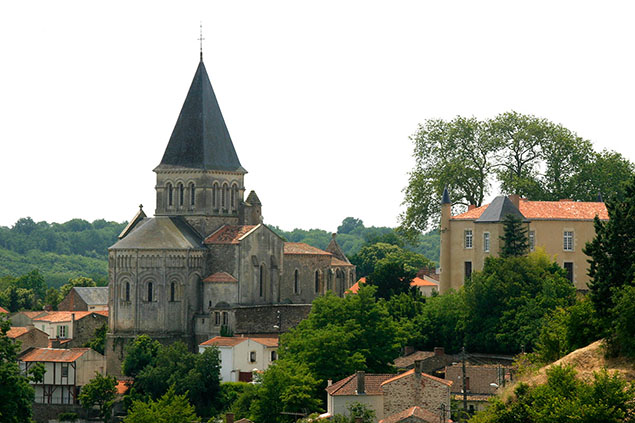 Peaceful countryside. Deep in the heart of the Vendee, the sea seems far away
Peaceful countryside. Deep in the heart of the Vendee, the sea seems far away
It boggles the mind to try and imagine the great French sailor Philippe Jeantot taking on the challenge of persuading the civil servants and politicians who run this relatively remote region of west France to permit, let alone sponsor, an event which is now utterly out on its own. Yet the regions of France quite rightly have an intense local pride. And if we in Ireland feel a tinge of envy at what they can achieve, just remember that last weekend it was announced that Wicklow Sailing Club had become the Mitsubishi Motors Club of the Year for 2017 thanks to their utter commitment to promoting the Round Ireland Race on a biennial basis, while at the same time continuing to function successfully as a club which caters for local sailing needs.
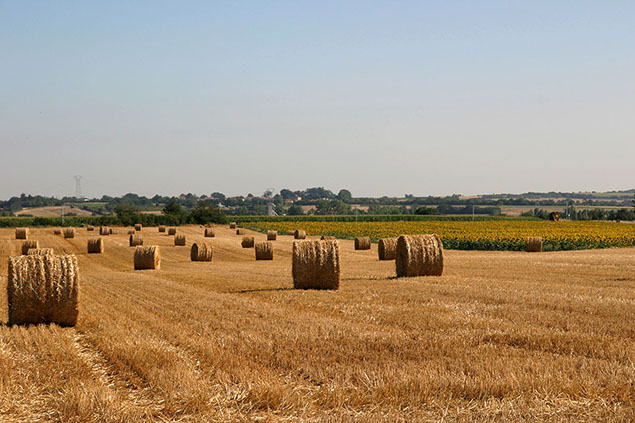 A summer cornfield in the Vendee is about as different as you can get…
A summer cornfield in the Vendee is about as different as you can get…
 ….from rounding Cape Horn in a rising gale. Yet both are linked through the world’s most challenging race
….from rounding Cape Horn in a rising gale. Yet both are linked through the world’s most challenging race
It’s something which is unusual in an overly-centralized country like Ireland, where all major decision are made in the capital, and in sailing you’d expect one of the main centres such as Cork Harbour or Dublin Bay or Belfast Lough to be the home of the Round Ireland race. But it is dogged little Wicklow which has won through, and 2016’s race fully justified their faith.
However, in the Irish context it is a local sailing club which is setting the pace. But in France, it is the regional administration which has been persuaded to pull off a remarkable coup. Looking at the scale and publicity which accompanies the Globe race, you’d assume it starts and finishes in a major centre such as Brest, or Lorient, or La Rochelle. Au contraire. The Vendee Globe starts and finishes in the very artificial sand-surrounded port of les Sables d’Olonne, set on a long sandy coast off which just about the only object of interest is the intriguing little Biscay island of Ile d’Yeu.
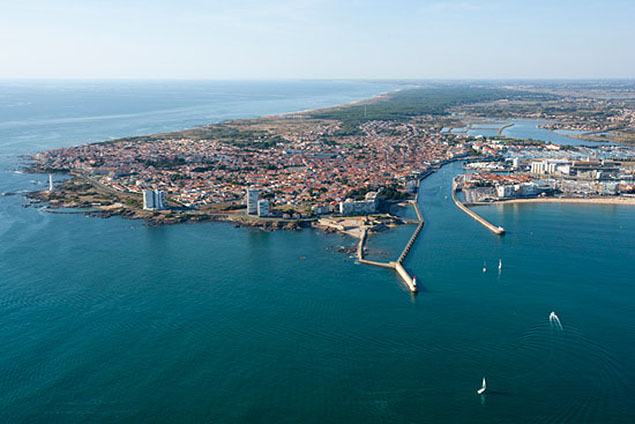 Les Sables d’Olonne, where the harbour is tucked in behind what used to be sand dunes
Les Sables d’Olonne, where the harbour is tucked in behind what used to be sand dunes
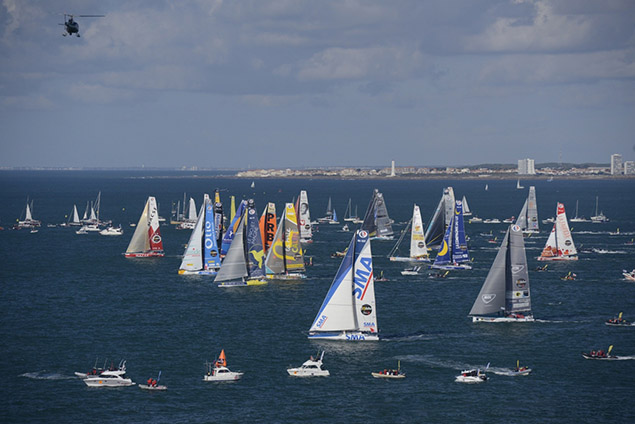 The start of the Vendee Globe 2016-2017
The start of the Vendee Globe 2016-2017
Yet despite the paucity of features of special interest along its sandy beaches, every three to four years sees Les Sables d’Olonne being swamped by hundreds of thousands of visitors when the Vendee Globe circus is in town. And this weekend, the focus sees the Race Headquarters move from their race-time base at the foot of the Eiffel Tower in Paris back to the quayside at Les Sables in anticipation of the finish, some time in the middle of next week, of the two fleet leaders.
Yesterday, gales on the Biscay coast prevented the re-installation of the super-tented Vendee Globe Village in Les Sables. But by today the command control should be broadcasting again on all media, and we can resume our daily doses of a fascinating event which is reaching its most crucial stage in an unexpected way.
For after a week in which severe storms have been sweeping most of Europe, a great big high pressure area is showing every sign of settling in over the southwest approaches to the Bay of Biscay right across the track which the two leaders – Armel le Cleac’h on Bank Populaire VIII and Alex Thompson closing up from 130 miles astern on Hugo Boss – will have to take to get to Les Sables.
C’est ridicule! The seas off northwest Spain - Galicia, Finisterre, whatever you want to call it – should be one of the stormiest places in the world in the latter half of January. Yet here it is, in an increasingly benign mood, with the final stages of the world’s breeziest race threatening to become a battle of the zephyrs.
 Enda O'Coineen and Stewart Hosford in Cork Harbour in 2015
Enda O'Coineen and Stewart Hosford in Cork Harbour in 2015
Under time-honoured traditional yacht racing tactics, all Le Cleac’h need to do is keep re-positioning himself so that he is directly between Thomson and the finish line. But these are not traditional yachts. Even in a zephyr, they can virtually create their own wind, and if the leader really does become so completely and utterly becalmed that he loses steerage way, the second-placed boat knows that his primary objective must be to maintain way even if it means actually heading away from the finish.
However, let’s face it, it is January, and it’s unlikely the total calm you might experience in high summer will ever settle in. That said, for le Cleac’h the situation is hugely challenging, for if there is one other skipper in the entire race who has the ability to pull off an audacious coup and snatch the lead, then it is 42-year-old Alex Thomson.
And in a sense, here in Ireland we can look on him as one of us. For five formative years of his childhood, he lived in the Crosshaven area, and his name can be found in the register of Templebreedy National School. His father Peter was a helicopter pilot on air-sea rescue duty, which meant that Alex was born in Bangor in North Wales as his father at the time was flying out of Anglesey, but then the move came to Cork airport, and the young Alex saw his first sailing off Weavers Point.
Sailing the seas of Cork at that time was young Stewart Hosford whose father Bill was one of the crew on Denis Doyle’s blue S&S designed Moonduster. Bill Hosford was also one of the consortium involved with Barry Burke in building the Ron Holland-desined Shamrrock racer-cruiser range, while for some added interest Bill and his wife Ann for ten years owned that deservedly renowned West Cork hostelry Mary Ann’s in the picturesque village of Castletownshend.
However, the challenge of life as an international banking executive drew young Stewart away from Cork, and he spent fifteen years in the City of London and another five in Edinburgh before the call of the sea returned, and he and his mates bought the Farr 65 Spirit of Diana in 2000 and linked up with the recent winning skipper in the Clipper Round the World Race, one Alex Thomson, to go racing. The rest is history.
 “Alex does the sailing and the stunts…..” A spot of keel-walking with Hugo Boss
“Alex does the sailing and the stunts…..” A spot of keel-walking with Hugo Boss
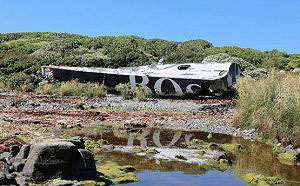 Even when things don’t go quite according to plan, somehow it still seems a success…
Even when things don’t go quite according to plan, somehow it still seems a success…
The synergy between the two men in creating a boat racing organization is extraordinary. Even though Stewart is now based back in Cork, life is totally peripatetic as he fulfills the role of CEO of Alex Thomson Racing, while Alex does the sailing and the stunts, and Sir Keith Mills is the third corner of a remarkable triangle for creating success.
The well-established link-up with Hugo Boss completed the package, and while on occasion things have gone spectacularly wrong, there’s something about an Alex Thomson Racing failure which makes it into a success. The man himself has a superhuman dedication and determination, and an ability to think completely outside the box, which makes their involvement in any event add greatly to its success.
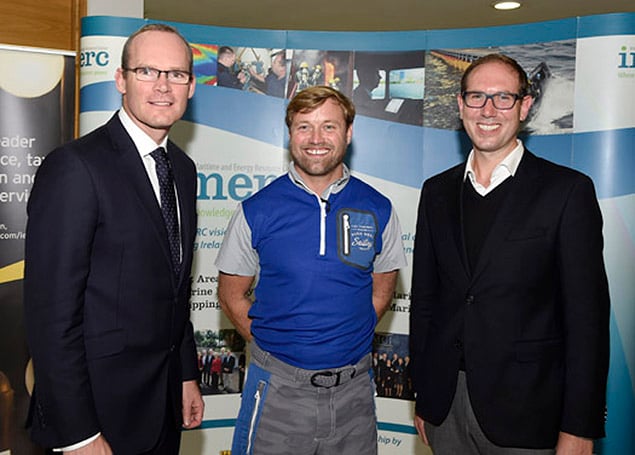 The then Minister for the Marine Simon Coveney with Alex Thomson and Stewart Hosford at a press briefing to put forward some proposals for developments on Cork Harbour
The then Minister for the Marine Simon Coveney with Alex Thomson and Stewart Hosford at a press briefing to put forward some proposals for developments on Cork Harbour
Most of us have lost count of how many different boats called Hugo Boss there have actually been, but there’s no doubt the current boat – after some setbacks which would have rebuffed a lesser squad – has evolved into on of the most formidable racing machines on the planet.
So even though it’s unlikely she’ll get starboard tack all the rest of the way to the finish in order for her lack of a starboard foil not to be a disadvantage, Hugo Boss racing has now reached such a level of attention that any outcome is ultra-newsworthy.
But though we talk of the Alex Thomson Racing challenges having reached a certain kevel, staying level is that last thing on the minds of these guys. They’ve all sorts of other ideas taking shape, and their track record is such that if they were so inclined, they could make a tidy living as consultants to nascent challenge projects. That is most unlikely. They’ve moved on a long way from Templebreedy. But even so, it still means a lot to Alex Thomson and Stewart Hosford when the latest Hugo Boss puts in an appearance at Crosshaven.
 Enda O’Coineen’s Kilcullen Voyager and the previous Hugo Boss off Crosshaven, where Alex Thomson spent five years of his childhood.
Enda O’Coineen’s Kilcullen Voyager and the previous Hugo Boss off Crosshaven, where Alex Thomson spent five years of his childhood.
Having established himself as a daredevil of the sport of sailing, this latest stunt involves frequent Cork Harbour visitor Alex Thomson, on a kiteboard, chasing his IMOCA open 60 HUGO BOSS boat upwind and attaching himself via a rope to the top of the boat’s mast. The solo skipper then utilises the speed of the race boat to propel himself 280ft into the air, sending him surfing above the vast yacht. When Thomson reaches the peak of his flight, he detaches himself from the boat and expertly controls his descent back down, landing the kiteboard on the water in true Alex Thomson style, all whilst wearing a stylish BOSS suit.
Thomson is captured during the feat in a series of remarkable still images, as he kitesurfs more than twice the height of his HUGO BOSS mast, a height equivalent to a 25–story building.
With a passion for pushing himself to the limit – and having previously executed two other death-defying challenges out on the water - solo skipper Thomson was keen to complete the trilogy of stunts.
The Skywalk was carried out by Alex Thomson Racing, in partnership with sponsors HUGO BOSS and Mercedes-Benz. In total, 35 people were involved in the planning, co-ordination and execution of the stunt, including Alex Thomson Racing Operations Manager Ross Daniel, professional kite-surfer Susie Mai and kite-surfing coach Ray Kasper.
Having safely returned to dry land Thomson commented: “The previous two stunts that we carried out - The Mastwalk and The Keelwalk - were so successful that, as a team, we just knew we couldn’t stop there. We were all in agreement; we wanted to do something even bigger and better.
“I’ve always had a love for all things wind-powered so naturally a stunt which involved kite surfing was the next step. The idea of combining two of my favourite sports and executing something which, to our knowledge, had never been done before was really exciting.
“The team and I have been planning the stunt for a long time. There were lots of things that could have gone wrong. Perhaps most concerning for the team; was the prospect of an uncontrolled descent, causing me to come back down too fast. Water can be as hard as concrete if hit with enough velocity, so this was one of the most dangerous aspects of the stunt. But I had a brilliant team around me and, with their help; we managed to pull it off.”
“What’s next? Who knows?”
This is the third daring stunt to be unveiled by the 41-year-old yachtsman and his team. Videos of The Keelwalk – a challenge which involved Thomson walking along the orange keel of his racing yacht, whilst heeled over and sailing at high speed – and The Mastwalk – which saw the skipper climb the 30 metre mast of HUGO BOSS and dive from the very top into the water – have now been viewed by more than 4.5m people around the world.
Thomson will compete in the pinnacle event of the Ocean Masters race calendar – the Vendée Globe - later this year, a race which begins on November 6th. The non-stop, solo, unassisted, round the world race takes approximately 80 days to complete. In the last edition of the race, back in 2013, Thomson finished in third place. This time around he is determined to be the first Brit to win the prestigious title.
Kayaker Finds Hugo Boss Yacht Abandoned 10 Years Ago
#AlexThomson - A remains of a yacht abandoned by sailing superstar Alex Thomson a decade ago have been discovered on a remote stretch of South American coastline.
According to Yachting & Boating World, the Hugo Boss skipper was forced to abandon the IMOCA 60 after a broken keel caused a capsize just five weeks into the first leg of the 2006-2007 Velux 5 Oceans offshore race.
But a decade on, Rolex Enterprise Award winner Cristian Donoso was kayaking in the Patagonia region of southern Chile recently when he found what remains of the Hugo Boss hull, located for the first time after it was set adrift in the Southern Ocean.
It's thought that the yacht travelled around 20,000km from the spot off South Africa where Thomson and crew were rescued by fellow Velux racer Mike Golding – moving east across the Indian and Pacific Oceans – to the shoreline at Bernardo O’Higgins National Park, north-west of South America's most southern city Punta Arenas.
Thomson, a regular visitor to Ireland whose replacement Hugo Boss Open 60 stopped off at Cork Harbour in April 2014, is now making arrangements for the boat's retrieval. YBW has more on the story HERE.
Rogue Wave Capsized Hugo Boss – Thomson
British sailor Alex Thomson and his co-skipper Guillermo Altadill are looking towards the 2016 Vendee Globe after an extraordinary sequence of events ended their participation in the Transat Jacques Vabre this weekend. The pair were rescued by the Spanish coastguard on Saturday afternoon after a rogue wave caught the new HUGO BOSS while the yacht was in a hove to position. The boat, which sustained damage to its rig in addition to taking on water while inverted, was later successfully brought to the dock in A Coruna, Spain, after a swift response from the Alex Thomson Racing Team.
The weather conditions in the first few days saw wind speeds in excess of 50 knots (75 km/h) and waves up to 10 metres high. Alex and Guillermo made the decision to take the safest route, passing the weather system to the south. Whilst travelling south west the yacht incurred some structural damage and the skippers took the decision to head for A Coruna, Spain 120 miles away.
The yacht was hove to, whilst Alex and Guillermo waited for the next weather window allowing them to proceed to port. Unexpectedly a rogue wave caught the racing yacht causing the yacht to turn upside down. Alex and Guillermo managed to close the hatches and secure the situation whilst inverted. Alex immediately hit the keel button, bringing the yacht back upright. They then alerted the rescue services and technical team of an emergency situation. The yacht had taken onboard a substantial amount of water and the rig had sustained damage requiring the skippers to leave the yacht.
Alex Thomson explains “I have never experienced anything like it. I was asleep and woke up to a boat upside down rapidly filling with water. Guillermo and I responded together as a team to the difficult situation and now that my boat’s back safely we can focus on our Vendee Globe campaign as a team. We have overcome problems before and I am as determined as ever to succeed.”
Always at the forefront of innovation, the team are pushing the boundaries with an advanced new boat design and know that race conditions provide the ultimate test.
Alex and Guillermo were aiming for a podium finish in the Transat Jacques Vabre, and remain determined to succeed in the Vendee Globe. They will now focus their energy on further improving the yacht and honing its competitive edge.
CEO of Alex Thomson Racing, Stewart Hosford, explained; “We are delighted to have the boat back on the dock and I am grateful to all of our team and the coastguard for their hard work and support. The team will now be working hard to assess and resolve the issues as quickly as possible so that we can resume our training programme. We are as determined as ever to get the boat back sailing and in race condition and continue to focus on the Vendee Globe.”
Hugo Boss Alex Thomson Rescue Video
The dramatic scene as Hugo Boss was rescued yesterday is captured by Spanish Coastguard helicopter.
Alex Thomson and Guillermo Altadill are now back on land after a successful rescue from the Spanish coast guard.
The Alex Thomson Racing Team is now heading back out to sea to bring HUGO BOSS safely ashore.
The skippers had made a second repair and were hove to (this is where the yacht is stationary and comfortably sits head to wind). The reason for slowing the racing yacht was to prevent any unnecessary damage. Whilst waiting for the weather to clear a rogue wave caught HUGO BOSS causing the yacht to turn upside down. Alex and Guillermo managed to close the hatches and secure the situation whilst inverted.
Alex immediately hit the keel button, bringing the IMOCA back upright.
They then alerted the rescue services and technical team of an emergency situation. The yacht had taken onboard a substantial amount of water and the rig had sustained damage requiring the skippers to leave the yacht.
Alex Thomson explains ‘It was an incredibly unusual event and we need to understand why it happened. It was a rogue wave, but we should not have inverted the way that we did. I am now going to go with the technical team and ensure a successful recovery of our new racing yacht.’
Emergency for HUGO BOSS in Transat Jacque Vabres: Alex Thomson & Guillermo Altadill Rescued
Alex Thomson and Guillermo Altadill, skippers of yacht HUGO BOSS in the Transat Jacques Vabre set off their emergency beacon this afternoon at 13.25UT. The Spanish Coastguard was informed and sent a rescue helicopter to their location 82 nautical miles from the Spanish coast. Both Alex and Guillermo were rescued from the location by helicopter and are on their way back to land. See rescue video here.
As Afloat.ie reported earlier this week, HUGO BOSS incurred some structural damage earlier this week forcing Alex and Guillermo to stop racing. The Skippers had made a repair and were on route to A Coruna where the technical team were waiting to meet them. After sailing for a period of 36 hours in high seas and strong winds, the structure of the boat deteriorated further and the boat started to take on water and sink. The technical team are in A Coruna, Spain awaiting further information from the coast guard.
In October Thomson and the brand new Hugo Boss made a pit stop in Cork Harbour because of 'small issues with the keel ram' but there is no information if this issue is in any way connected with today's evacuation.
Managing Director Stewart Hosford expresses ‘Our first concern is with Alex and Guillermo and when they are safely on the ground we will address the situation with our IMOCA 60 and begin the salvage process. We are grateful for the swift response from the rescue services in this situation.’
Transat Yacht Hugo Boss Heads For Repairs in Vigo
After unsuccessfully attempting a repair for several hours at sea, Transat Jacques Vabre competitors and frequent Irish visitors Alex Thomson and Guillermo Altadill onboard HUGO BOSS have made a partial repair but it will not allow the duo to cross the Atlantic so the difficult decision to proceed to Vigo, Spain has been made.
The current sea state and weather forecast have not aided the situation onboard.
The technical team is currently en route to Vigo, Spain, to join the crew and try to complete repairs.
Technical Director Ross Daniel explains; 'It is disappointing that the current sea state and approaching weather system have forced us to return to land to make the repair. But it is early days in our training programme as we understand the new boat and work towards the start of the Vendee Globe 2016. We will do everything we can to try and return to the Transat Jacques Vabre as soon as possible.'
#Open60 - There was plenty of action on the water in and around Cork Harbour this afternoon (Sunday 12 July) as the Atlantic Youth Trust's IMOCA 60 Kilcullen Voyager took on the Alex Thomson-skippered Hugo Boss in a special challenge race as part of this weekend's SeaFest events.
Indeed, it's not every day Cork Harbour plays host to not one, but two of the world's highest performing ocean racing yachts - particularly one with a record-breaking offshore pedigree, and the other sailing with youth sail trainees taking up a once-in-a-lifetime opportunity to get on-deck experience at sailing's pinnacle.
Despite the relative lack of experience on the Irish boat, they certainly gave Thomson and crew a run for their money today, closing a significant gap to cross the finish line only a minute or so behind the professionals.
Hugo Boss well ahead of Killcullen, currently about 3 miles south of Roches Point @Seafest_ie pic.twitter.com/aW1L51l0Mm
— Gavin Deane (@gavinroyalcork) July 12, 2015#MastWalk Wins Best Use of PR
#mastwalk – The latest stunt created by Alex Thomson Racing saw the single handed skipper take a dramatic dive from the tip of the HUGO BOSS mast. The #MastWalk has been a viral sensation with his channel boasting over a million views in a matter of days. The stunt required organisation and attention to detail. Alex Thomson Racing had to modify the vessel to achieve this magnificent stunt. Hazards and dangers with completing the footage required Alex Thomson and his team to plan, train and of course find the perfect conditions. The crew worked together to ensure a global media sensation. The helmsman had little steerage as the tip of the rudder skimmed the surface of the sea.
The yacht HUGO BOSS had to remain heeled over at 60 degrees to ensure Alex could walk the 30 metre mast and dive from great height, with this amazing racing machine on the edge of broaching. Philip Burghaus Marketing Manager from HUGO BOSS said "We did not expect to win this award but as a major sponsor of sailing, we believe sailing as a sport provides outstanding sponsorship value as demonstrated tonight" Alex Thomson Racing achieved the #MastWalk viral sensation working alongside the media production company WING and their PR agency PHA media boasting over 1.5 million views in a matter of days.
Working alongside HUGO BOSS Alex Thomson Racing produced a unique and innovative way to create an award winning Digital PR campgain.




























